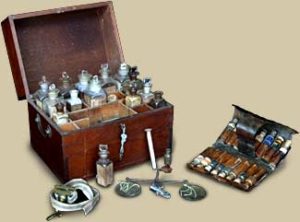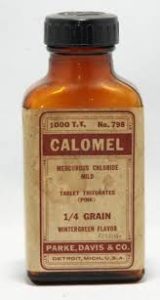
Medicine Chest circa 1850, and Pocket Pill Case circa 1820, courtesy University of Virginia Historical Collection at the Claude Moore Health Sciences Museum
By the middle and late 1800s, so-called “heroic” medicine (in which extraordinary measures to cure a condition often endangered the patient) had been abandoned. However, patients were sometimes little better off calling a doctor than if they had simply endured the illness they suffered.
To treat diarrhea, for instance, doctors may have first ordered a cathartic–a medicine to accelerate the evacuation of the bowels, and then followed it with laudanum, Dover’s powder (a combination of ipecac and opium), or morphine. The latter concoctions probably relieved distress, and opium does slow the gut so that it will treat diarrhea, but they certainly shouldn’t have been taken for any chronic condition.
Head lice were common in crowded living conditions, and patients were advised to soak the hair on their heads with kerosene and wrap it up in a cloth for 24 hours. Since smoking was also common during this era, patients would have to take great care that nothing worse happened to their hair than an invasion of lice.
Doctors commonly used arsenic and mercury–both deadly–to treat syphilis in the 1800s. They also used mercury to treat typhoid fever, parasites, depression, cholera, teething pain in babies, and scurvy, usually through a mercury-based compound called calomel. Heroin, opium, and morphine were commonly used by physicians and dispensed readily (and without prescriptions) by town druggists; these ingredients permeated common medicines or what we now call “patent” medicines, sold over the counter throughout the country.

